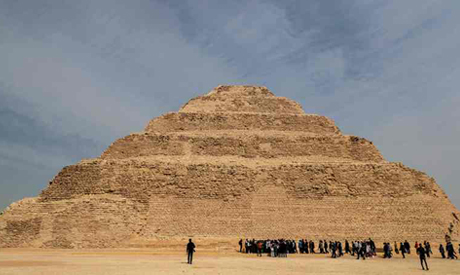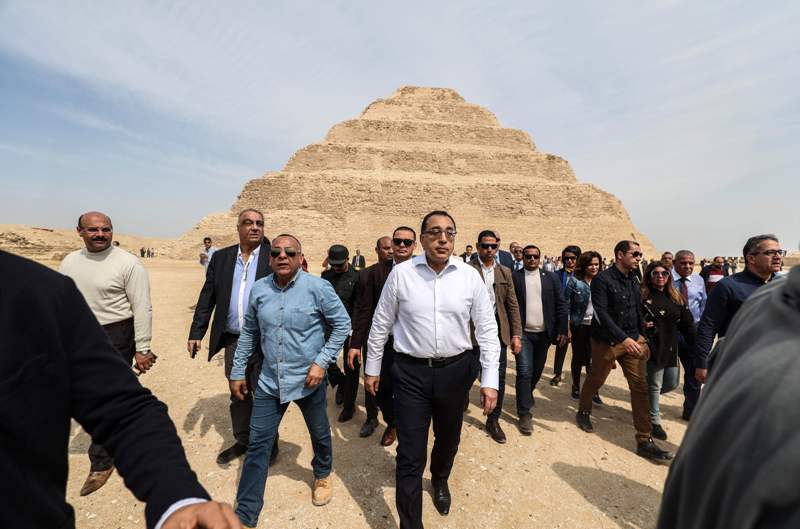
Tourists visist the step pyramid of Djoser in Egypt's Saqqara necropolis, south of the capital Cairo, on March 5, 2020. (AFP)
The serenity of the Saqqara necropolis was disturbed today as the archaeological site was buzzing with people who flocked to attend the grand opening of Djoser’s Step Pyramid, the first stone building in history and the oldest pyramid in the world.
Among the attendees were Prime Minister Mostafa Madbouly, Minister of Tourism and Antiquities Khaled El-Enany and Assem El-Gazar, the minister of housing.
At the press conference following the inauguration, Madbouly said opening the Djoser Pyramid after restoration was an honour. “This project, along with other project in the field of archaeology, is one of the country’s mega projects. Egypt is keen to preserve its unique heritage and it is on top of its priorities,” Madbouly said.
“This is a meticulous medical surgery,” El-Enany told Ahram Online, explaining that the restoration work that took 14 years has been carried out by skillful and efficient Egyptian conservators with a budget of EGP 104 million.

Egyptian Prime Minister Mostafa Madbouly (C) leaves after a press conference in front of the step pyramid of Djoser in Egypt's Saqqara necropolis, south of the capital Cairo, on March 5, 2020. (AFP)
The Step Pyramid is the highlight of Saqqara’s monuments. It is the oldest monumental stone building in history and Egypt’s oldest pyramid. It was commissioned by Djoser (c 2667–2648 BC). The genius architect was Imhotep. He designed a layout in which the Step Pyramid was at the centre of a larger funerary complex. The pyramid itself consists of six stacked terraces to a height of around 63 metres.
The dimensions of the base are 121 x 109 metres. The pyramid has two entrances, one on its northern side, which is the original entrance, and another on the southern, which dates back to the 26th Dynasty. The complex also includes a colonnade entrance, the South Tomb, the Sed Festival court, the Pavilions of the North and South, and a funerary temple to the north of the pyramid.
El-Enany explained that the restoration aimed at consolidating the pyramid and removing the damages. Accumulated dust, sand, and stones containing damaging salts were removed from the surfaces of the terraces. Stone blocks that had loosened were restored, and gaps between the façade blocks were filled with the same archaeological material that had been used in the construction of the pyramid.
Degraded stone blocks were treated using materials immediately after the removal of the soil covering them. The walls of the deteriorated underground passages were treated with injections and reinforced materials, or with careful restoration methods.
The southern entrance was prepared to serve as the main entrance into the pyramid for visitors.
The stones in the collapsed area above the central shaft were unstable and in a critical state of structural equilibrium. Loss of mortar between the blocks had occurred, causing them to detach from each other, causing gaps to form.
The primary objective was to stabilise the ceiling blocks (the area of initial collapse) in three stages. Loose ceiling blocks were reconnected by filling the gaps between them with lime mortar, a material similar in composition to the original mortar, to a depth of no less than 25 centimetres. Air stents were distributed in all hazardous locations to render the work area safe for workers.

Tourists pose for a photograph at the standing step pyramid of Saqqara after its renovation, south of Cairo, Egypt March 5, 2020. (Reuters)
El-Anany said the area around the pyramid was developed. New placards with information of the pyramid and its restoration work were installed. A visiting path was created and a slope was made for the disabled. A new lighting system was installed.
The burial chamber and its corridors were restored. Rubble was completely removed and taken outside the pyramid, revealing a granite sarcophagus and guaranteeing its structural stability.
After the rubble was removed, the sarcophagus was found to consist of 32 granite blocks, with sides measuring 3.47 × 5.35 metres, and a height of 4.73 metres. Its total weight is estimated at around 176 tons. The coffin was found resting on 18 limestone bases, all of which had collapsed, filling the burial chamber with rubble.

Tourists take pictures at the archaeological site of the standing step pyramid of Saqqara after its renovation, south of Cairo, Egypt March 5, 2020. (Reuters)
Short link: